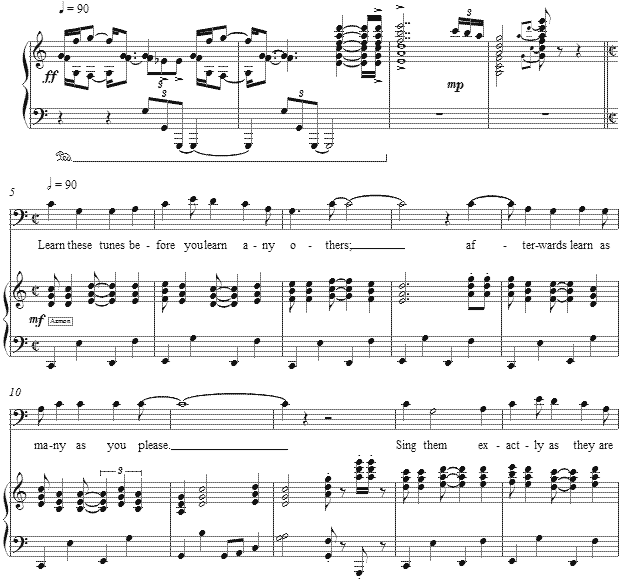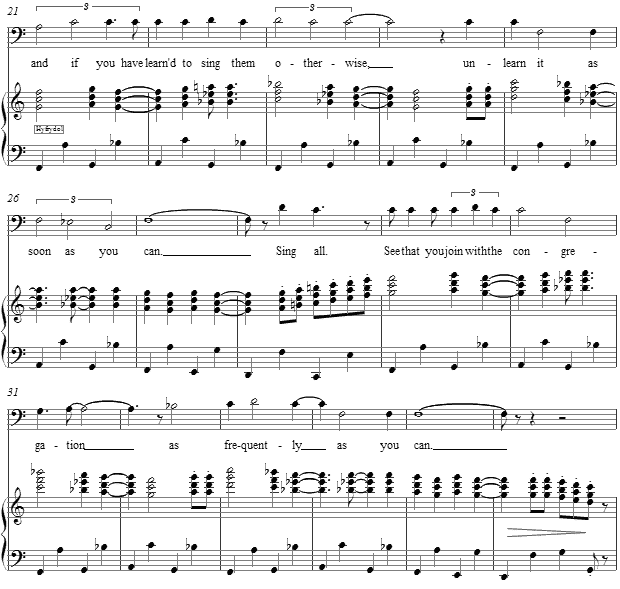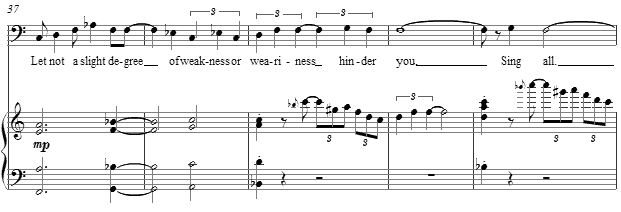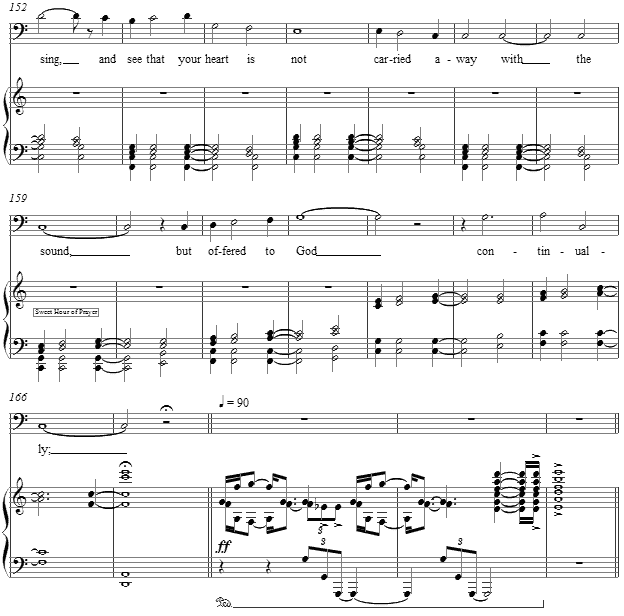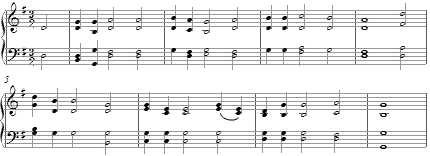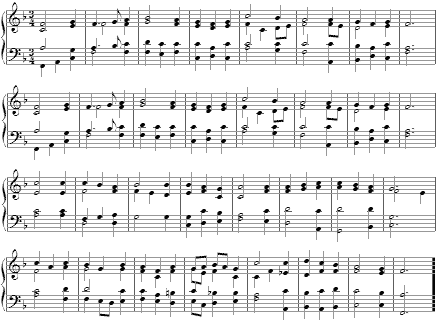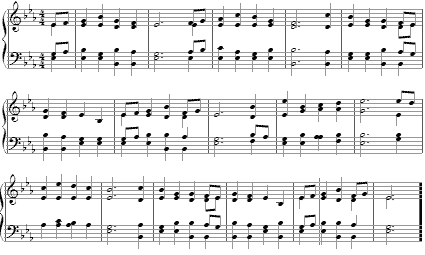Music and Texts of GARY BACHLUND
Vocal Music | Piano | Organ | Chamber Music | Orchestral | Articles and Commentary | Poems and Stories | Miscellany | FAQs
Directions for Singing - (2009)
John Wesley
for baritone and piano
for baritone Bruce Perry
Learn these tunes before you learn any others; afterwards learn as many as you please.
Sing them exactly as they are printed here, without altering or mending them at all; and if you have learned to sing them otherwise, unlearn it as soon as you can.
Sing all. See that you join with the congregation as frequently as you can. Let not a slight degree of weakness or weariness hinder you. If it is a cross to you, take it up, and you will find it a blessing.
Sing lustily and with a good courage. Beware of singing as if you were half dead, or half asleep; but lift up your voice with strength. Be no more afraid of your voice now, nor more ashamed of its being heard, than when you sung the songs of Satan.
Sing modestly. Do not bawl, so as to be heard above or distinct from the rest of the congregation, that you may not destroy the harmony; but strive to unite your voices together, so as to make one clear melodious sound.
Sing in time. Whatever time is sung be sure to keep with it. Do not run before nor stay behind it; but attend close to the leading voices, and move therewith as exactly as you can; and take care not to sing too slow. This drawling way naturally steals on all who are lazy; and it is high time to drive it out from us, and sing all our tunes just as quick as we did at first.
Above all sing spiritually. Have an eye to God in every word you sing. Aim at pleasing him more than yourself, or any other creature. In order to do this attend strictly to the sense of what you sing, and see that your heart is not carried away with the sound, but offered to God continually; so shall your singing be such as the Lord will approve here, and reward you when he cometh in the clouds of heaven.
[ 9 pages, circa 4' 50" ]
John Wesley
John Wesley was an Anglican cleric and Christian theologian, largely credited with founding the evangelically-oriented Methodist movement which became highly successful in the United Kingdom. Among his methods was the appointment of itinerant, un-ordained preachers who travelled widely to evangelize and care for people in the organized "methodist" societies. Their assistants were called "exhorters", and this movement took up interest in prison reform and the abolition of slavery. During Wesley's life, he asserted that his work was well within the boundaries of the Anglican church, per se, though his unusual methods put him into conflict with church hierarchy as well. He and his brother, Charles, contributed many hymn texts to the church culture. It was late in his life that he ordained Thomas Coke for ministry in the United States, and through this came an independent course for Methodism.
In discussing this text of seven exhortation as suggested by Bruce Perry (for whom I also composed a setting of Percy Bysshe Shelley's Music, when Soft Voices die), I learned that certain melodies are most closely associated with the hymn texts which Wesley authored. For this I chose to use some of these hymns as a starting point for the musical materials, as well as a humorous and extremely oblique reference to Tu es petrus, which also figured into our transatlantic conversation. The hymns which I chose were known as Azmon [ 1 ], Hyfrydol [ 2 ] and Beata terra [ 3 ], and as the first two were in triple time notation, I resolved to change the rhythms to fit into a square duple rhythm, with a quasi stride piano texture.
The "lustily" delivered opening gesture yields to a dominant in the diatonic, quartal harmonies of this setting. Thereupon the opening exhortation is accompanied by a modified quote of the Methodist hymn, Azmon, which is forced from its normal 3/2 meter and into this square, music hall styled duple meter.
After two repetitions of the Azmon theme, in the subdominant appears the hymn tune Hyfrydol, which is twisted from its original 3/4 meter to become compatible with this duple setting. This tune is not used in its entirety. The additional of some non-harmonic tones emphasize the modern use of this classic melody.
This syncopated duple texture gives way to a longer lined moment of parallel seven chords and a jazz "lick" which refreshes the mood.
Yet another hymn tune, Terra beata, appears, as the setting becomes a kind of rondo or chain form in which new material continues to crop up. This hymn tune is originally in 4/4 time, such that some small syncopations were all that was needed to employ it as further accompaniment to the Wesley text.
Tempos moderate, and at the more devout advice a meno mosso allows a more serious tone and texture. The slightest opening gesture from another hymn, Sweet Hour of Prayer (which I cited also in the last movement of An Echoe from the Shore to texts of Walt Whitman), makes prayerful this moment, before the onrushing reprise of the opening and a return to the Azmon section.
The score for Directions for Singing is available as a free PDF download, though any major commercial performance or recording of the work is prohibited without prior arrangement with the composer. Click on the graphic below for this piano-vocal score.
NOTES
[ 1 ] The hymn tune known as Azmon was composed by Carl G. Glaser and arranged by Lowell Mason in 1839, to a text of John Wesley's brother, Charles Wesley, (1707-1788). The tune was made popular in several denominations, but especially well known in Methodist churches for the association with the Wesleys.
[ 2 ] Hyfrydol was composed by Rowland H. Prichard, (1811-1887), the best known harmonization found in The English Hymnal, 1906, and is also for a text by Charles Wesley from 1747. This hymn tune is also well known in several denominations, especially in the Methodist church, and a beloved chorale prelude based on it was composed by Ralph Vaughan Williams.
[ 3 ] Terra beata is the familiar name for a traditional English melody sometimes known as Rusper. A previous melody to the text of John Wesley fell from favor and was replaced by this melody in an early 20th century arrangement by Franklin Sheppard (1915).

